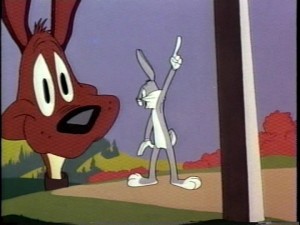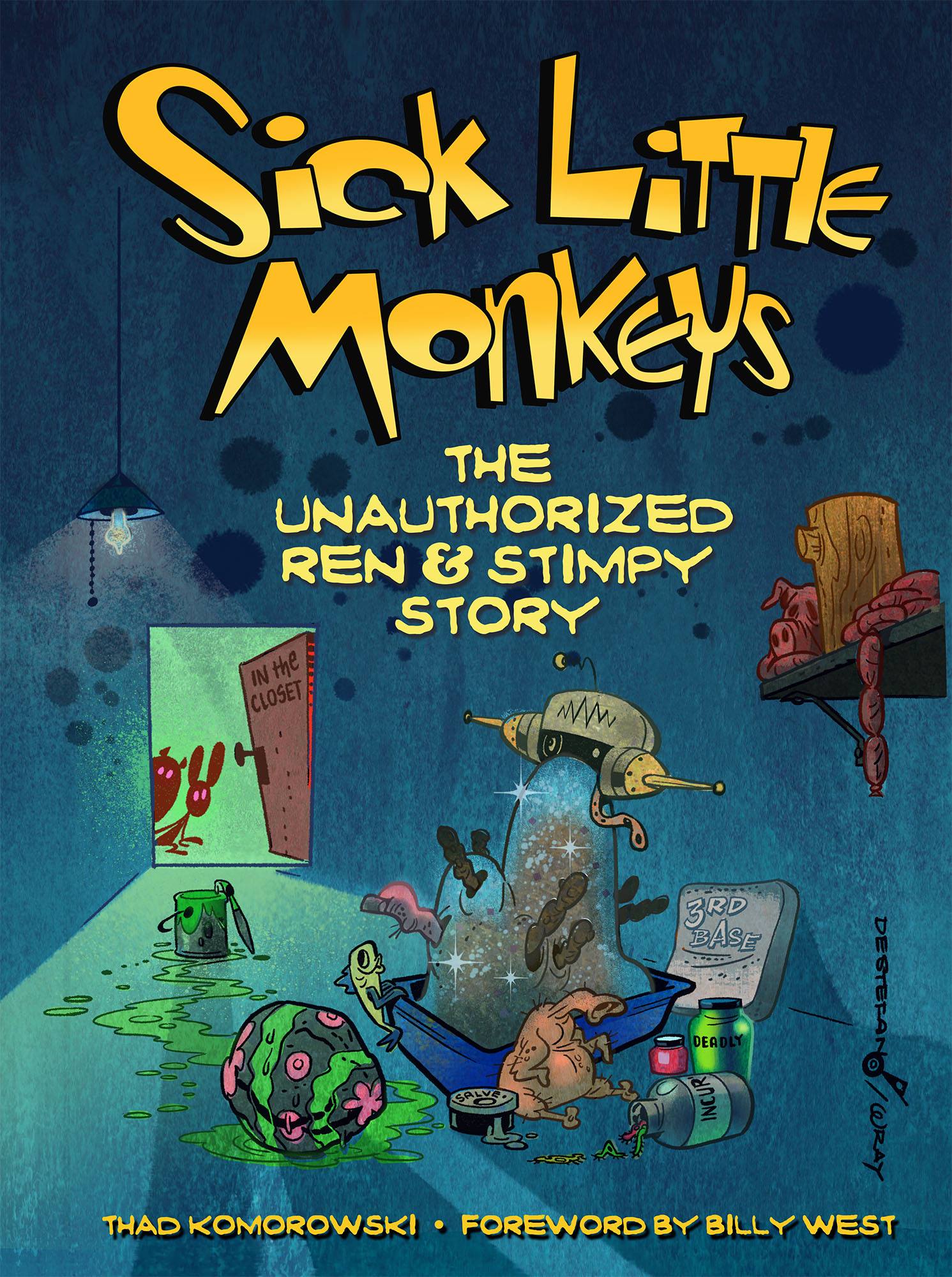 I’ve been periodically adding information to the WB Production Number Project as more original release prints and artwork have come my way. This tidbit, though, comes from film archivist and historian Bob Furmanek, regarding the release date of Lumber Jack-Rabbit, the only cartoon Warners released in 3-D.
I’ve been periodically adding information to the WB Production Number Project as more original release prints and artwork have come my way. This tidbit, though, comes from film archivist and historian Bob Furmanek, regarding the release date of Lumber Jack-Rabbit, the only cartoon Warners released in 3-D.
It was released in 3-D on September 25, 1953 and re-released flat on November 13, 1954. It premiered on September 25, 1953 at the Hollywood and downtown Paramount theaters with the WB 3-D feature, The Moonlighter. Thanks to some bogus data in an error-riddled 3-D book, that wrong 1954 release date is all over the Internet!
I’ve amended the entry for Jack-Rabbit on my site. It would be helpful if those who like to mess around with Wikipedia and the IMDB would do some good and add this information there as well.
I’ve launched the Facebook page for my upcoming book, Sick Little Monkeys: The Unauthorized Ren & Stimpy Story, where I’ll be posting Ren & Stimpy related minutiae on a semi-daily basis. Spread the word, and keep an eye out, there and here, for updates regarding publication. If there is interest, maybe I will start occasionally posting some of the various interviews I did for the book here.


Thank you very much, Thad. This is one of many 3-D myths that we are trying to clear up. The wrong November 1954 release date for this cartoon has appeared in SO many places, both online and in print. The myth has now become fact.
I truly appreciate your good efforts to get the correct information out there!
For more 3-D Myths, please check out this page on our site: http://www.3dfilmarchive.com/home/top-10-3-d-myths
Best,
Bob Furmanek
3-D Film Archive
I found “Lumber Jack Rabbit” in an ad for the Saxon Theatre in Fitchburg, Mass., where it was playing Sept. 25-26, 1953 along with “The Moonlighter” and “Dangerous Crossing” with Jeanne Crain. I suppose that’s when it became available from the WB exchange.
The earlier release date makes sense, because the cartoon has always looked like it belonged with Jones’ works from the 1953 release season. By 14 months later (and even accounting for extra production time for the 3-D effects), the UPA influences had hit Warners full-force, especially in the Jones-Maurice Noble pairing. But there’s only the smallest of hints of those changes here (plus LJR has no title ‘bunching’ to the center of the picture on the cartoon to allow it to be cropped for widescreen, as with all the other ’54 releases).
J. Lee –
Remember (That’s the point of this p-number guide of Thad’s after all) that despite being released earlier in ’53, LJR was actually produced around the same time as Jones’ other 1954 release season cartoons. I’m guessing this was shipped out earlier than the others to supply the theatrical “need” for 3-D films (Disney’s, Lantz’s, and Famous’s 3-D cartoons were also released around this time).
The 1953 shutdown is something to consider here too. Since the studio was temporarily closed due to thinking that soon all their films would be made in 3-D, it would make more sense to release their only 3-D film in ’53 rather than ’54 since if it had been released that much later (with the original crew back again), they would have already known 3-D was not as “hot” a commodity as first thought.
Well, everything from the Jones unit up through 1955’s”Past Perfumance” was produced prior to the March 1953 shutdown, so in real-time terms, the shift over to the more UPA stylized work by the Jones unit all occurred before LJR was released. It probably would have been more accurate for me to say that Chuck referred to his being bored with the idea of the 3-D process, and the cartoon itself exhibits some of that not just in the bland storyline, but in the fact there was no real effort to do anything ‘edgy’ or different with the short, other than the shield zoom at the outset (and it’s interesting, as a side note, that while Chuck was bored with the 3-D nature of the short, he and Maltese saw something in tiny Bugs versus a big opponent, because they also made “Beanstalk Bunny” just prior to the shutdown).
Yowp’s listed date for the Massachusetts theater’s showing would put the cartoon between Chuck’s “Zipping Along” and “Duck! Rabbit! Duck!” on the release schedule. The production numbers may not match the sequence, but the cartoon’s visuals make it feel like that’s where it belongs, right in the period where Jones and Noble were only dipping their toes in the UPA waters.
Apart from the bouncing shield and various depth gags (Bugs sees the dog tag as a billboard, and looks down), think there was only ONE actual made-for-3D gimmick: The perspective gag of when Paul Bunyan heads for the “distant” mountains and steps over them.
Only seen it in flat, so don’t know how many out-of-screen gimmicks there may have been (eg. when the dog points the gun). Too bad Chuck’s characteristic diva act kept Warner’s toons from going further into 3D when Warner was the most active 3D studio, but even as LJR doesn’t seem to “know why” it’s 3D, it still feels more genuine Golden-Age 3D than those hyperactive Wile E. toons being ground out by the current studio without Chuck’s sense of timing.
March? I thought the shutdown was in June 1953.
Whoops. June ’53 is correct. Don’t know where I got March from (preview is your friend…)
According to the Thomas Pryor piece in the New York Times on June 17: “The halt of cartoon production also can be attributed to technical changes now taking place in filming methods and to the fact that the company has a large reserve of such products on hand. Forty cartoons are ready for release and a number of others are in the color-processing stage.” The article also mentions that “a skeleton crew of about ten will be kept on during the summer according to present indications, to handle some outside commercial work.”
According to a Variety article on December 4, the animation department will resume production on January 4, 1954 and will be composing for 1.75:1 while still protecting for the standard 1.37:1 ratio.
Warner Bros. had adapted the same widescreen policy for their features in May of 1953.
Part of the problem with LJR lies in the fact that it was pushed through production so quickly. Warner Bros. had begun filming HOUSE OF WAX on January 19, 1953. WAX was rushed through production and had its world premiere less than three months later (record time!) at the New York Paramount Theater on April 10, 1953. WB captured lightning in a bottle with that feature and it remains one of the top 3-D films of all time.
LJR would have gone into production sometime in January or February and it hit theaters in late September. At that time, what was the usual turnaround time on a cartoon, from inception to release?
Despite a comment in the trivia section on IMDB, LJR was never intended as a companion short to HOUSE OF WAX. It played most 3-D engagements in late 1953/early 1954 with either THE MOONLIGHTER or John Wayne’s HONDO.
I believe Chuck Jones is quoted as being disappointed with the results and I suspect the rush had something to do with it. Although, I’m not sure of the accuracy of those quotes because one makes reference to the viewer having one red and one blue pupil. LJR, as all the the 3-D cartoons and features, was originally shown in dual-strip Polaroid, similar to the current 3-D releases with gray-tinted glasses.
One thing this cartoon achieved which the other 3-D ones did not was the gradual and continuous increase of depth through the various planes. The other cartoons simply used layers (as the 3-D comic books) to achieve depth.
With the exception of Disney’s MELODY and WORKING FOR PEANUTS, this was the only Golden Age 3-D cartoon composed for 1.37:1. The others were intended for widescreen: POPEYE, THE ACE OF SPACE and BOO MOON from Paramount were composed for 1.66:1, and THE HYPNOTIC HICK from Universal-International was meant for 1.85:1.
According to the cartoon’s production number, Jones began this cartoon between CLAWS FOR ALARM and STOP LOOK AND HASTEN so this cartoon actually began production sometime in 1952 as that’s when those other cartoons were produced. According to Thad, the overall production backlog time on the WB theatrical release schedule was 18-24 months so even if it did begin production in 1952 at the earliest, it’s being released in September 1953 puts it only a year after its’ production so that’s definitely a record if the earliest they usually got to theaters was 18 months after completion.
Warner Bros. did not even contemplate producing a film in 3-D until December 1952. If LJB was truly in production as early as 1952, then it was conceived as a flat cartoon. The 3-D treatment would have happened at the eleventh hour, or at the earliest in the early months of 1953.
Guys, there’s a lot of wild speculation going on here. The production numbers only serve as a guide to the order the cartoons were started. There were many cartoons in various stages of production during the 1953 hiatus; for example, PIZZICATO PUSSYCAT was most certainly completely animated before the Freleng unit disbanded, but its music track wasn’t recorded until April 1954. You won’t get that kind of info looking at the numbers alone.
This ren and stimpy book is going to be fascinating.
So for “Pizzicato Pussycat” the music track was recorded after the animation was completed? I supposed musica and audio track were usually made before the animation.
Looks like the misinformation has already been fixed on imdb and Wikipedia. (though imdb still lists the cartoon as “1954”, its release date is listed as September 25, 1953 like it should)
Re: Pizzicato Pussycat: The music for that short was by Milt Franklyn. Does this mean that Stalling was originally going to do the music for it, but handed it to Franklyn instead when the studio re-opened?
As to that, I have no idea. Franklyn is credited on the documentation as the composer, with no mention of Stalling.
Thanks for spreading the word. At least when in a few years time when I come to review this short on my blog – I will know that this was from 1953.
Thank you, Mr. Furmanek, for straightenting the date. David Mackey also set it straight on his long running Warner Brois.cartoon filmography.